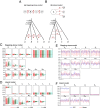Efficient Bayesian inference under the multispecies coalescent with migration
- PMID: 37871206
- PMCID: PMC10622872
- DOI: 10.1073/pnas.2310708120
Efficient Bayesian inference under the multispecies coalescent with migration
Abstract
Analyses of genome sequence data have revealed pervasive interspecific gene flow and enriched our understanding of the role of gene flow in speciation and adaptation. Inference of gene flow using genomic data requires powerful statistical methods. Yet current likelihood-based methods involve heavy computation and are feasible for small datasets only. Here, we implement the multispecies-coalescent-with-migration model in the Bayesian program bpp, which can be used to test for gene flow and estimate migration rates, as well as species divergence times and population sizes. We develop Markov chain Monte Carlo algorithms for efficient sampling from the posterior, enabling the analysis of genome-scale datasets with thousands of loci. Implementation of both introgression and migration models in the same program allows us to test whether gene flow occurred continuously over time or in pulses. Analyses of genomic data from Anopheles mosquitoes demonstrate rich information in typical genomic datasets about the mode and rate of gene flow.
Keywords: BPP; gene flow; genomics; migration; multispecies coalescent.
Conflict of interest statement
The authors declare no competing interest.
Figures







Similar articles
-
A Bayesian Implementation of the Multispecies Coalescent Model with Introgression for Phylogenomic Analysis.Mol Biol Evol. 2020 Apr 1;37(4):1211-1223. doi: 10.1093/molbev/msz296. Mol Biol Evol. 2020. PMID: 31825513 Free PMC article.
-
Power of Bayesian and Heuristic Tests to Detect Cross-Species Introgression with Reference to Gene Flow in the Tamias quadrivittatus Group of North American Chipmunks.Syst Biol. 2023 Jun 16;72(2):446-465. doi: 10.1093/sysbio/syac077. Syst Biol. 2023. PMID: 36504374 Free PMC article.
-
Inferring the Direction of Introgression Using Genomic Sequence Data.Mol Biol Evol. 2023 Aug 3;40(8):msad178. doi: 10.1093/molbev/msad178. Mol Biol Evol. 2023. PMID: 37552932 Free PMC article.
-
Challenges in Species Tree Estimation Under the Multispecies Coalescent Model.Genetics. 2016 Dec;204(4):1353-1368. doi: 10.1534/genetics.116.190173. Genetics. 2016. PMID: 27927902 Free PMC article. Review.
-
Coalescent methods for estimating phylogenetic trees.Mol Phylogenet Evol. 2009 Oct;53(1):320-8. doi: 10.1016/j.ympev.2009.05.033. Epub 2009 Jun 6. Mol Phylogenet Evol. 2009. PMID: 19501178 Review.
Cited by
-
The power of coalescent methods for inferring recent and ancient gene flow in endangered Bactrian camels.Proc Natl Acad Sci U S A. 2025 Aug 5;122(31):e2410949122. doi: 10.1073/pnas.2410949122. Epub 2025 Jul 28. Proc Natl Acad Sci U S A. 2025. PMID: 40720656 Free PMC article.
-
Inference of Gene Flow between Species from Genomic Data When the Mode, Direction, and Lineages are Misspecified.Mol Biol Evol. 2025 Jun 4;42(6):msaf121. doi: 10.1093/molbev/msaf121. Mol Biol Evol. 2025. PMID: 40575924 Free PMC article.
-
The Impact of Sequencing and Genotyping Errors on Bayesian Analysis of Genomic Data under the Multispecies Coalescent Model.Mol Biol Evol. 2025 Jul 30;42(8):msaf184. doi: 10.1093/molbev/msaf184. Mol Biol Evol. 2025. PMID: 40823878 Free PMC article.
-
Bayesian Inference Under the Multispecies Coalescent with Ancient DNA Sequences.Syst Biol. 2024 Nov 29;73(6):964-978. doi: 10.1093/sysbio/syae047. Syst Biol. 2024. PMID: 39078610 Free PMC article.
-
Hierarchical Heuristic Species Delimitation Under the Multispecies Coalescent Model with Migration.Syst Biol. 2024 Nov 29;73(6):1015-1037. doi: 10.1093/sysbio/syae050. Syst Biol. 2024. PMID: 39180155 Free PMC article.

